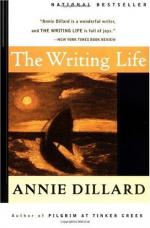
|
| Name: _________________________ | Period: ___________________ |
This test consists of 5 multiple choice questions, 5 short answer questions, and 10 short essay questions.
Multiple Choice Questions
1. What was Dillard's painter neighbor, Glenn, working on for six months in Chapter 6?
(a) Folded sculpture.
(b) Landscapes painted by dripping paint on canvas.
(c) Dipping papers into vats of colored oil on water.
(d) Painting over marbleized papers.
2. With what type of aid did Dillard once work in order to keep a project organized?
(a) A fax machine.
(b) Two computers going at once.
(c) A twenty-foot conference table.
(d) A paper sorter.
3. Where did Willa Cather write her prairie novels?
(a) Kansas City.
(b) New York City.
(c) Wisconsin.
(d) Miami.
4. Who once said about writing, 'Know your own bone'?
(a) Thoreau.
(b) Truitt.
(c) Ibsen.
(d) Whitman.
5. What is the topic of an essay written by Dillard that she said she considers too obscure and too intellectual?
(a) A moth.
(b) Popcorn.
(c) Lions.
(d) A mustang.
Short Answer Questions
1. What made the teakettle in the faculty lounge look so interesting in Chapter 3?
2. What did Dillard notice most in the Washington cabin she wrote in?
3. What happened to the Smith-Corona typewriter in Chapter 4?
4. Who or what will teach someone to write, according to Dillard in Chapter 3?
5. What did Emily Dickinson love best in her writing?
Short Essay Questions
1. Why did the island on Haro Strait haunt Dillard?
2. What does Dillard mean in Chapter 5 when she writes, '...instead we watch television and miss the show'?
3. Why does Dillard say that the life of the mind of a writer is hard to be called "living"?
4. How does Dillard say that she learned the correct way to split wood on the chopping block?
5. Why does Dillard say it makes more sense to write one big book than to write many stories or essays?
6. Why does Dillard say that she needed more materials than a pencil and paper in order to write something like a second draft for a thirty-page chapter?
7. In Chapter 4, Dillard's typewriter erupted. What was the damage done?
8. How does a work in progress turn on its author, according to Dillard?
9. How does Dillard compare a writer to a Seminole alligator wrestler?
10. Why does Dillard advise writers not to hoard a good idea for a later place in a book being written or for another book?
|
This section contains 1,006 words (approx. 4 pages at 300 words per page) |

|




